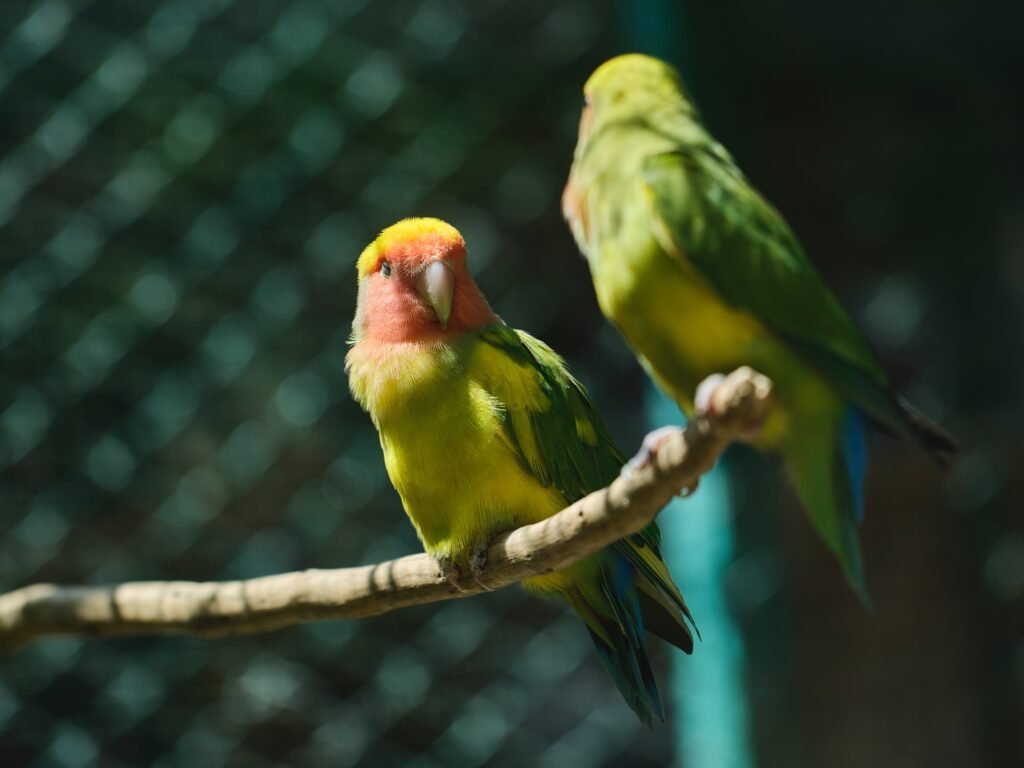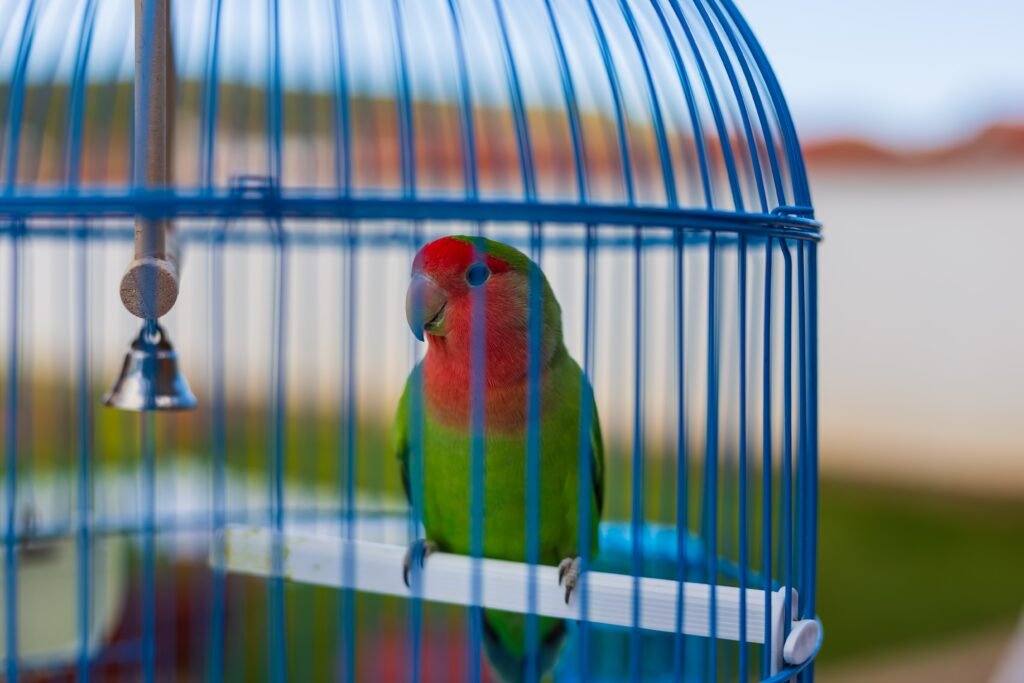Lovebirds are delightful and charming birds that make wonderful pets. To ensure their well-being and happiness, creating the perfect living space for them is crucial. This article will guide you through the habitat requirements for your lovebirds, providing you with all the necessary information to create an ideal environment that promotes their physical and mental health.
Cage Size and Structure
The size and structure of the cage are of utmost importance when it comes to providing a comfortable habitat for your lovebirds. A spacious cage allows them to move around freely and exercise their wings. Generally, the minimum recommended cage size for a pair of lovebirds is 24 inches in width, 18 inches in depth, and 24 inches in height.
- In addition to the minimum recommended size, a larger cage will give your lovebirds even more space to explore and fly within the confines of their home.
- Consider a cage with multiple levels or platforms, providing vertical space for your lovebirds to climb and explore.
- Choosing a cage made of sturdy materials like stainless steel or wrought iron is essential. These materials ensure durability and prevent your lovebirds from damaging or escaping the cage.
- Avoid cages with gaps that could trap your lovebirds or allow them to escape. Additionally, ensure the cage bars are spaced no more than 1/2 inch apart to prevent the birds from sticking their heads through and getting injured.
Cage Placement
Proper cage placement is essential to create a stress-free environment for your lovebirds. Place the cage in a well-lit area, away from direct sunlight and drafts. Lovebirds are highly social birds and thrive on interaction, so it is best to position their cage where they can observe the household activities and feel included.
- Find a location that allows your lovebirds to be part of the family while providing them security and privacy. Avoid placing the cage in isolated areas where they may feel neglected.
- Keep the cage away from the kitchen or any areas with potentially toxic fumes. Lovebirds are sensitive to airborne pollutants, so maintaining clean air quality in their surroundings is crucial for their well-being.
- Ensure the cage is placed at a suitable height so that you can easily access it for cleaning and maintenance.
Perches
Perches are necessary for lovebirds as they provide a place to rest, exercise, and maintain their nails. Select perches of various diameters to stimulate their feet and prevent foot problems. Natural wooden perches are an excellent choice as they resemble branches found in the wild and promote foot health.
- In addition to wooden perches, consider providing other materials such as rope or cement perches. This variety will offer different textures and help keep your lovebirds’ feet in optimal condition.
- Position the perches at different heights within the cage to enable your lovebirds to exercise their flight muscles as they move from one perch to another. This will mimic their natural behavior in the wild and promote physical activity.
- Placing some perches near their food and water dishes will encourage them to eat and drink regularly. This arrangement also mimics their natural habitat, where they can find perches near food sources.
Toys and Enrichment
Lovebirds are intelligent and curious creatures that require mental stimulation to prevent boredom and promote overall well-being. Provide them with various toys and enrichment activities to keep them entertained.
- Toys that allow for climbing, chewing, and foraging are particularly beneficial. Consider providing ladders, swings, and hanging toys to keep your lovebirds physically active and mentally engaged.
- Puzzle toys that require the birds to work for their treats will provide mental stimulation and prevent boredom. These toys can be filled with treats or food that your lovebirds need to figure out how to access.
- Rotate the toys regularly to keep your lovebirds engaged and prevent them from losing interest. Introducing new toys periodically will provide novelty and excitement for your feathered companions.
Sleep and Privacy
Lovebirds need a quiet and dark environment to get adequate rest. Covering the cage partially or completely with a breathable fabric or using a specifically designed cage cover can create a cozy sleeping space for your feathered companions. Ensure the cover allows proper ventilation and does not obstruct the cage’s entry points.
- Consider providing a separate, smaller sleeping cage for your lovebirds. This can be placed inside their main cage, offering them a safe and quiet space to sleep undisturbed.
- Maintain a consistent sleep routine by providing your lovebirds with a quiet, undisturbed area during their designated sleep time. A lack of proper rest can lead to stress and behavioral issues, so ensuring a peaceful sleeping environment is crucial for their well-being.
Diet and Nutrition
A balanced and nutritious diet is vital for your lovebirds’ overall health and well-being. Offer a variety of fresh fruits, vegetables, and high-quality pellets as the main components of their diet. Avoid feeding them avocado, chocolate, caffeine, alcohol, and other foods that may be toxic to birds.
- Gradually introduce new fruits and vegetables to allow your lovebirds to adjust to different flavors and textures. Offer a wide variety to ensure they receive essential vitamins and minerals.
- Supplement their diet with small amounts of seeds, nuts, and grains. These treats can be given sparingly and used as rewards during training sessions.
- Fresh, clean water should be available at all times. Change the water daily to ensure its freshness and cleanliness. Consider using a water dispenser or a water bottle to prevent contamination.
Hygiene and Cleanliness
Maintaining cleanliness in your lovebirds’ habitat is crucial for their health. Regularly clean the cage and all accessories, such as perches and toys. Remove any uneaten food, droppings, or debris from the cage daily.
- Use mild, bird-safe cleaning products to avoid harmful chemicals that could be toxic to your lovebirds. Avoid using strong disinfectants or bleach, as these can be harmful if not rinsed thoroughly.
- Regularly wash and disinfect the food and water dishes to prevent the growth of harmful bacteria. Dry them thoroughly before refilling to avoid the growth of mold or mildew.
- Consider providing a separate bathing dish or misting your lovebirds with water to help them maintain their feather condition and cleanliness.
Conclusion
Creating the perfect living space for your lovebirds is essential for their well-being and happiness. By providing a spacious cage, proper cage placement, perches of various diameters, toys for mental stimulation, a quiet sleeping environment, a balanced diet, and maintaining cleanliness, you can ensure your lovebirds thrive in their habitat. Remember to spend quality time with your lovebirds, offering them companionship and affection, as they are highly social creatures that require interaction.
FAQ
- What is the recommended cage size for a pair of lovebirds?
The minimum recommended cage size for a pair of lovebirds is 24 inches in width, 18 inches in depth, and 24 inches in height.
- Where should I place the cage for my lovebirds?
Place the cage in a well-lit area, away from direct sunlight and drafts. Position the cage where your lovebirds can observe household activities and feel included.
- What types of perches should I provide for my lovebirds?
Provide natural wooden perches of various diameters to stimulate your lovebirds’ feet. You can also consider rope or cement perches for different textures and foot health.
- How can I keep my lovebirds entertained?
Provide a variety of toys and enrichment activities for your lovebirds, such as climbing toys, swings, and puzzle toys. Rotate the toys regularly to keep them engaged and introduce novelty.


